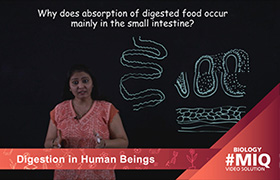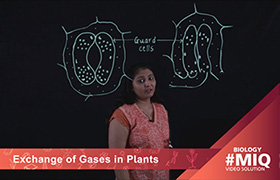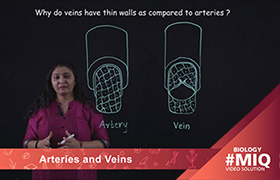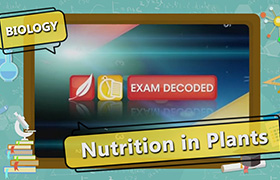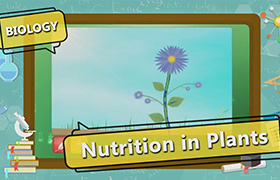CBSE Class 10 Answered
CAN YOU PLEASE EXPLAIN THE MONOHYBRID CROSS AND DIHYBRID CROSS?
Asked by Abhirami | 15 Jan, 2016, 17:12: PM
Hi,
Monohybrid Cross - A cross which involves only a single pair of contrasting characters.
- Consider pea plants with a pair of contrasting characters—tallness and dwarfness—with respect to the height of the stem. Because pea plants are self-fertilising, Mendel bred them for several generations till he obtained pure varieties. The parental generation P1 has the genotype TT for a pure tall parent plant and tt for a pure dwarf plant. The two parents are homozygous with one type of gamete each, i.e. T from tall parent and t from dwarf parent. These two plants are crossed with one another.
- Mendel found that all plants were tall. He called them first filial or F1 generation seeds. The F1 generation has genetic constitution Tt. It is genotypically a hybrid and a heterozygous plant with two different alleles. Phenotypically, the plant is tall because the allele or the gene T for tallness masks the effect of its corresponding recessive gene t.
- F1 plants are self-pollinated to obtain the F2 generation.
- The second filial generation F2 has a genotypic ratio of 1 TT:2 Tt:1 tt. In this case, because the allele T for tallness is dominant, the pea plants with genotype Tt will be tall. The phenotypic ratio is 3 tall:1 dwarf. Genotypically, it shows 3 types of plants: 1 TT, which is homozygous tall, 2 Tt which are heterozygous tall and 1 tt which is homozygous dwarf. Thus, the genotypic ratio is 1 TT:2 Tt:1 tt.
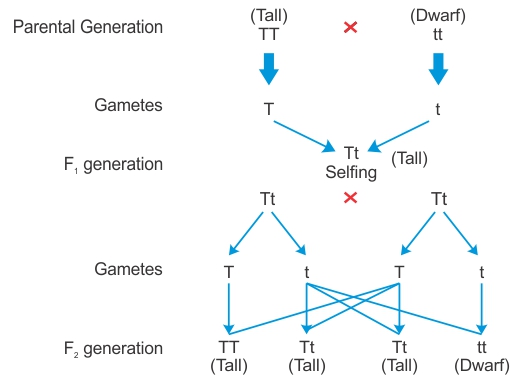
Dihybrid Cross - A cross which involves plants with two pairs of contrasting characters
- Consider a cross of pea plants with round and yellow seeds and plants with wrinkled and green seeds. In this cross, the two pairs of characters involved are seed shape and seed colour.
- The capital letter R is used to denote round-shaped seeds and capital Y to denote yellow-coloured seeds. The genotype of the parent plant is RRYY. The other parent has wrinkled seeds which are green in colour. The letter small r denotes wrinkled seeds and small y denotes green-coloured seeds. The genotype of the parent is rryy. The two parent plants are then crossed, RRYY × rryy.
- Mendel observed that the F1 plants were with round yellow seeds phenotypically. The genotype of these F1 hybrids was RrYy.
- When F1 plants are self-pollinated, the four types of male gametes and four types of female gametes produce in all 16 different mating combinations.
- The F2 generation obtained by self-pollination of F1 plants exhibits 16 plants with different genotypes. Of a total of 16 plants, 9 plants are with round and yellow seeds RRYY, 3 are with wrinkled and yellow seeds rrYY, 3 are with round and green seeds RRyy and 1 is with wrinkled and green seed rryy. Thus, the phenotypic ratio of F2 plants is 9:3:3:1.
- Genotypically, there are 9 different types of plant combinations—RRYY, RrYy, Rryy, rryy, RRYy, rrYy, Rryy, Rryy and rrYY. The genotypic ratio is 1:4:1:1:1:2:2:2:2.
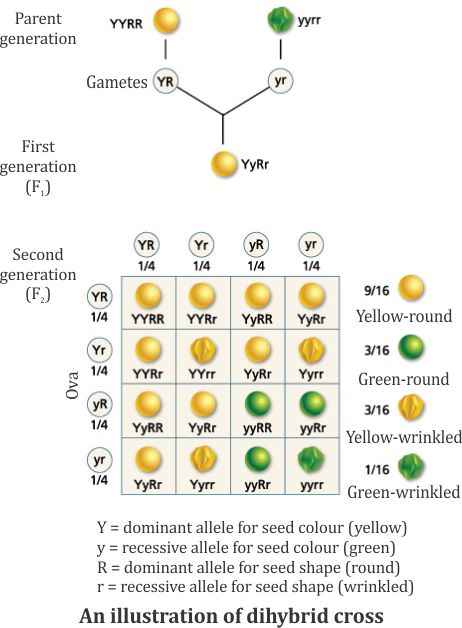
Answered by | 15 Jan, 2016, 18:01: PM
Application Videos
Concept Videos
CBSE 10 - Biology
Asked by nsvramanaramana | 27 Jun, 2024, 18:54: PM
CBSE 10 - Biology
Asked by debilalsontop5 | 19 Jun, 2024, 05:45: AM
CBSE 10 - Biology
Asked by roshanraj73367 | 31 May, 2024, 14:23: PM
CBSE 10 - Biology
Asked by chaudharykavya508 | 17 May, 2024, 17:20: PM
CBSE 10 - Biology
Asked by kunchalasrinivasaraosrinivasar | 23 Apr, 2024, 19:40: PM
CBSE 10 - Biology
Asked by bgmigaurav7318 | 08 Apr, 2024, 13:46: PM
CBSE 10 - Biology
Asked by rashmij34 | 04 Mar, 2024, 12:04: PM
CBSE 10 - Biology
Asked by jayeshsah1995 | 04 Mar, 2024, 12:01: PM
CBSE 10 - Biology
Asked by ar3886267 | 01 Mar, 2024, 17:57: PM

